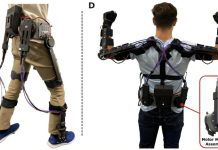
Researchers from Shibaura Institute of Technology (SIT) in Japan have made a significant breakthrough by creating a unique, origami-based grasping mechanism for quadcopters, commonly known as drones.
This new technology, detailed in a study published in IEEE Robotics and Automation Letters, is designed to enhance drones by enabling them to pick up objects, a feature that could revolutionize fields like agriculture, land surveying, and disaster management.
The research team, led by Associate Professor Hiroki Shigemune, along with master’s student Shuta Okamoto and Professor Chinthaka Premachandra, has developed a lightweight and cost-effective solution to equip drones with the ability to grasp objects.
This is particularly challenging because adding any extra weight to a drone can affect its ability to fly.
The solution lies in the art of origami, the traditional Japanese technique of paper folding. By using paper, the team crafted a robust yet lightweight gripper that can be easily mounted on a drone.
Unlike previous origami grippers, which required complex additional mechanisms to switch from a resting state to an active grasping state, SIT’s design is ingeniously simple.
Their device, named the Self-folded Origami Gripper (SOG), can automatically fold itself into the desired shape using a novel method developed by Dr. Shigemune over the past decade.
The process involves using a regular inkjet printer and a cutter machine to pre-cut paper and apply wet ink in a specific pattern.
The interaction between the ink and the paper initiates a self-folding action due to the physicochemical reactions.
The SOG operates on a bistable principle, meaning it has two stable shapes and can switch between them when a specific amount of force is applied.
It uses a “water bomb” design, which flips from one configuration to another with a simple poke at its center. This action allows the SOG to grasp objects securely by snapping shut around them.
Remarkably, despite being made entirely of paper, the SOG is incredibly effective. It weighs just 5 grams but can grasp objects weighing up to 130 grams.
This capability was demonstrated in practical tests where the SOG was attached to a drone and successfully grabbed a spherical object from a wooden branch.
Another significant advantage of using paper for the gripper is its environmental friendliness. Paper is biodegradable, meaning the SOG will naturally decompose and return to the soil if it falls off the drone, posing no harm to the environment or wildlife.
The successful implementation of this origami-inspired gripper opens up new possibilities for drones, making them more versatile and environmentally friendly tools for various applications.
The team at SIT hopes that their innovative design will pave the way for further advancements in smart origami devices for multifunctional drones.



